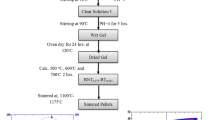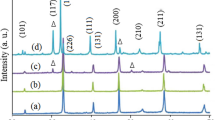Abstract
Electrophoretic deposition (EPD) process has certain advantages such as it can be applied for a mass production and also can be combined with magnetic crystal alignment technique. In this work, we prepared lead-free 85(Bi0.5Na0.5)TiO3–15BaTiO3 (85BNT–15BT) piezoelectric ceramics by conventional uniaxial pressing and EPD process. Various conditions were optimized such as suspension media, applied electrical field, and deposition time in order to yield dense green ceramics of 85BNT–15BT composition using EPD process. 85BNT–15BT ceramics prepared using EPD process revealed the Curie temperature of about 250 °C, coercive field of about 30 kV/cm, and piezoelectric constant (d 33) of 75 pC/N. The EPD-processed samples exhibited structural and electrical properties similar to that of the conventionally processed one suggesting the successful fabrication of 85BNT–15BT piezoelectric ceramics by EPD method without composition deviation. This study lays a foundation on the fabrication of Bi-based lead-free piezoelectric ceramics by an alternative route other than the conventionally practiced solid-state reaction method maintaining the similar chemical composition, moreover, leaving a large space to explore more in the future.








Similar content being viewed by others
References
Uchino K (1997) Piezoelectric actuators and ultrasonic motors. Springer, Berlin
Official Journal of the European Union (2003) Directive 2002/95/EC of European Parliament and of the Council of 27 January 2003. http://eur-lex.europa.eu/LexUriServ/LexUriServ.do?uri=OJ:L:2003:037:0019:0023:EN:PDF Accessed 29 June 2017
Takenaka T, Maruyama K, Sakata K (1991) (Bi1/2Na1/2)TiO3–BaTiO3 system for lead-free piezoelectric ceramics. Jpn J Appl Phys 30(9B):2236
Sung YS, Kim JM, Cho JH, Song TK, Kim MH, Park TG (2010) Roles of lattice distortion in (1−x)(Bi0.5Na0.5)TiO3–xBaTiO3 ceramics. Appl Phys Lett 96:202901
Xu C, Lin D, Kwok KW (2008) Structure, electrical properties and depolarization temperature of (Bi0.5Na0.5)TiO3–BaTiO3 lead-free piezoelectric ceramics. Solid State Sci. 10(7):934–940
PI Ceramic, Catalog: PI piezoelectric ceramic products. https://www.piceramic.com/en/products/piezoceramic-actuators/piezoelectric-crystal/. Accessed 29 June 2017
Li J-F, Wang K, Zhu F-Y, Cheng L-Q, Yao F-Z (2013) (K, Na)NbO3-Based Lead-free piezoceramics: fundamentals aspects, processing technologies, and remaining challenges. J Am Ceram Soc 96(12):3677–3696
Lee MH et al (2015) High-performance lead-free piezoelectrics with high curie temperatures. Adv Mater 27(43):6976–6982
Park S-E, Shrout TR (1997) Relaxor based ferroelectric single crystals for electromechanical actuators. Mater Res Innov 1(1):20–25
Park S-E, Shrout TR (1997) Ultrahigh strain and piezoelectric behavior in relaxor based ferroelectric single crystals. J Appl Phys 82(4):1804
Wada S, Yako K, Kakemoto H, Tsurumi T, Kiguchi T (2005) Enhanced piezoelectric properties of barium titanate single crystals with different engineered-domain sizes. J Appl Phys 98:014109
Wada S, Takeda K, Muraishi T, Kakemoto H, Tsurumi T, Kimura T (2007) Preparation of [110] grain orientation barium titanate ceramics by templated grain growth method and their piezoelectric properties. Jpn J Appl Phys 46(10B):7039–7043
Kobayashi E et al (2015) Fabrication of (111)-oriented tetragonal BaTiO3 Ceramics by an electrophoretic deposition in a high magnetic field. Trans Mater Res Soc Jpn 40(3):223–226
Sugiyama T, Tahashi M, Sassa K, Asai S (2003) The control of crystal orientation in non-magnetic metals by imposition of a high magnetic field. ISIJ Int 43:855–861
Watanabe T et al (2011) Structural transformation of hexagonal (0001)BaTiO3 ceramics to tetragonal (111)BaTiO3 ceramics. Jpn J Appl Phys 50(9S2):09ND01
Matsuda M, Miyatake M, Umegaki T, Yamashita K (2004) Electrophoretic coagulation behavior of ferroelectric barium titanate powders in mixed solutions of alcohol and acetylacetone. J Mater Sci 39(13):4235–4238. doi:10.1023/B:JMSC.0000033404.14266.ef
Vriami D, Damjanovic D, Vleugles J, Biest OV (2015) Textured BaTiO3 by templated grain growth and electrophoretic deposition. J Mater Sci 50(24):7896–7907. doi:10.1007/s10853-015-9322-4
Okamura S, Tsukamoto T, Koura N (1993) Fabrication of ferroelectric BaTiO3 films by electrophoretic deposition. Jpn J Appl Phys 32(9B):4182–4185
Mahajan A, Pinho R, Dolhen M, Costa ME, Vilarinho PM (2016) Unleashing the full sustainable potential of thick films of lead-free potassium sodium niobate (K0.5Na0.5NbO3) by aqueous electrophoretic deposition. Langmuir 32(21):5241–5249
Dolhen M, Mahajan A, Pinho R, Costa ME, Trolliard G, Vilarinho PM (2015) Sodium potassium niobate (K0.5Na0.5NbO3, KNN) thick films by electrophoretic deposition. RSC Adv 5(6):4698–4706
Doungdaw S, Uchikoshi T, Noguchi Y, Eamchotchawalit C, Sakka Y (2005) Electrophoretic deposition of lead zirconate titanate (PZT) powder from ethanol suspension prepared with phosphate ester. Sci Technol Adv Mater 6(8):927–932
Zhitomirsky I (2002) Cathodic electrodeposition of ceramic and organoceramic materials. Fundamental aspects. Adv Colloid Interface Sci 97(1–3):279–317
Jordan TL, Ounaies Z (2001) Piezoelectric ceramics characterization, National Aeronautics and Space Administration (NASA). ICASE Report No. 2001-28
Acknowledgements
The authors would like to thank Nippon Chemical industrial and Sakai Chemical Industry Co., Ltd., for providing (Bi0.5Na0.5)TiO3 and BaTiO3 powders. The experiment at SPring-8 was carried out under Program No. 2016A1401.
Author information
Authors and Affiliations
Corresponding author
Rights and permissions
About this article
Cite this article
Kim, M., Ito, R., Kim, S. et al. Fabrication of lead-free piezoelectric (Bi0.5Na0.5)TiO3–BaTiO3 ceramics using electrophoretic deposition. J Mater Sci 53, 2396–2404 (2018). https://doi.org/10.1007/s10853-017-1717-y
Received:
Accepted:
Published:
Issue Date:
DOI: https://doi.org/10.1007/s10853-017-1717-y




